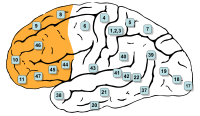
Photo from wikipedia
&NA; Human frontal cortex is commonly described as being insensitive to sensory modality, however several recent studies cast doubt on this view. Our laboratory previously reported two visual‐biased attention regions… Click to show full abstract
&NA; Human frontal cortex is commonly described as being insensitive to sensory modality, however several recent studies cast doubt on this view. Our laboratory previously reported two visual‐biased attention regions interleaved with two auditory‐biased attention regions, bilaterally, within lateral frontal cortex. These regions selectively formed functional networks with posterior visual‐biased and auditory‐biased attention regions. Here, we conducted a series of functional connectivity analyses to validate and expand this analysis to 469 subjects from the Human Connectome Project (HCP). Functional connectivity analyses replicated the original findings and revealed a novel hemispheric connectivity bias. We also subdivided lateral frontal cortex into 21 thin‐slice ROIs and observed bilateral patterns of spatially alternating visual‐biased and auditory‐biased attention network connectivity. Finally, we performed a correlation difference analysis that revealed five additional bilateral lateral frontal regions differentially connected to either the visual‐biased or auditory‐biased attention networks. These findings leverage the HCP dataset to demonstrate that sensory‐biased attention networks may have widespread influence in lateral frontal cortical organization. Graphical abstract Figure. No caption available. HighlightsSensory‐biased attention networks extend into human lateral frontal cortex (LFC).Small N dataset used to mine Human Connectome Project dataset (N = 469).RS‐functional connectivity confirms 4 sensory‐biased LFC regions bilaterally.5 new putative sensory‐biased attention regions observed bilaterally in LFC.
Journal Title: NeuroImage
Year Published: 2017
Link to full text (if available)
Share on Social Media: Sign Up to like & get
recommendations!